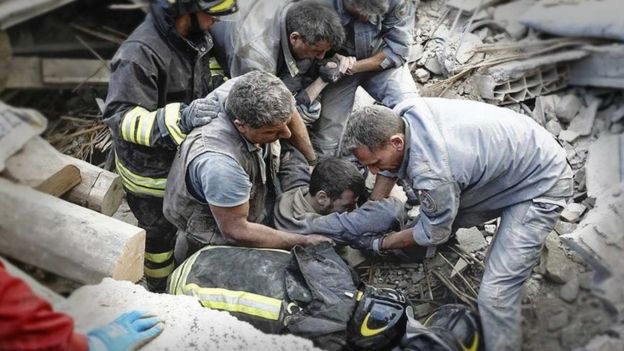At least 73 people have been killed in an earthquake that hit a mountainous area of central Italy, authorities say.
The magnitude 6.2 quake struck at 03:36 (01:36 GMT), 100km (65 miles) north-east of Rome, not far from Perugia.
Many of the dead were in Accumoli, close to the epicentre, and a short distance away in Amatrice, where three-quarters of houses were destroyed.
Many people are still believed buried under the rubble, and the death toll is expected to rise.
Prime Minister Matteo Renzi paid tribute to the volunteers and civil defence officials who had rushed to the scene in the middle of the night and used their bare hands to dig for survivors,
The quake struck at a shallow depth of 10km and its intensity was compared to that of the Aquila earthquake in April 2009 in which 309 people died.
Some buildings in the capital shook for 20 seconds as the quake struck the regional border area of Umbria, Lazio and Le Marche. It was felt from Bologna in the north of Italy to Naples in the south. Some 80 aftershocks have been reported since.
Italy’s civil protection department said that at least 73 people were now known to have been killed.
While the full extent of casualties is still emerging, Italian news agency Ansa is reporting that it believes at least 35 people have been killed in Amatrice and 11 in Accumoli, and another 17 in the villages of Arquata del Tronto and Pescara del Tronto.
The mayor of Arquata del Tronto, Aleandro Petrucci, spoke of a disaster. “The village isn’t there anymore. Almost all the houses in Pescara del Tronto have collapsed.”
An elderly couple and a boy were among the victims there, while 20 people have been taken to hospital.
Two boys aged four and seven were pulled alive from the rubble of the house they had been staying in with their grandmother, Ansa reports.
Rescuers were still trying to reach the remote village of Peracchia di Acqua Santa Terme a few kilometres to the east.
Some of the worst damage was in Amatrice. The missing there include three nuns.
“The roads in and out of town are cut off,” said mayor Sergio Pirozzi. “Half the town is gone. There are people under the rubble. There’s been a landslide and a bridge might collapse.
“There are tens of victims, so many under the rubble. We’re preparing a place for the bodies.”
Residents described using sheets to climb down from the upper floors of damaged houses. The local hospital was described as unusable and survivors were taken to nearby towns for treatment.
The town’s 13th Century bell tower was one of the few historic buildings in the centre that remained standing. Amatrice is popular with holidaymakers from Rome.
The BBC’s James Reynolds, who is in Amatrice, said that sniffer dogs were being sent into buildings to search for more survivors.
In Accumoli, a short distance to the north of Amatrice, Mayor Stefano Petrucci said a family of four, including two small children, were missing under a collapsed house.
A local photographer spoke of 15 rescuers digging with bare hands to try to reach the family.
“They can hear the screams of the mum and one of the children,” he said.
Rescuers were also trying to dig out a 58-year-old man trapped in his home.
Accumoli is popular with holidaymakers and most of the 2,500 people left displaced by the earthquake were said to be visitors.
Mr Renzi promised affected areas that “no family, no city, no hamlet will be left alone”.
Mediterranean seismicity is driven by the great collision between the African and Eurasian tectonic plates; but when it comes down to the specifics of this latest quake, the details are far more complicated.
The Tyrrhenian Basin, or Sea, which lies to the west of Italy, between the mainland and Sardinia/Corsica, is slowly opening up.
Scientists say this is contributing to extension, or “pull-apart”, along the Apennines. This stress is compounded by movement in the east, in the Adriatic.
The result is a major fault system that runs the length of the mountain range with a series of smaller faults that fan off to the sides. The foundations of cities like Perugia and L’Aquila stand on top of it all.
Seismologist Andrea Tertulliani said there were sure to be further, numerous shocks that would probably diminish in intensity.
“But it can’t be ruled out that there could be another shock on the same scale as the main one,” he added.
Italy’s civil protection agency described the earthquake as “severe”.
“It was so strong,” Lina Mercantini of Ceselli, Umbria, told Reuters. “It seemed the bed was walking across the room by itself with us on it.”
BBC
 Q FM Africa's Modern Radio
Q FM Africa's Modern Radio
